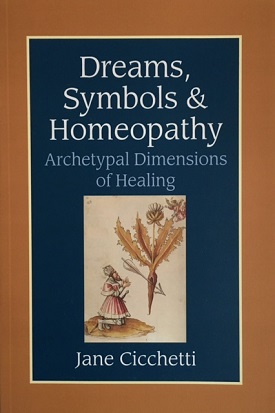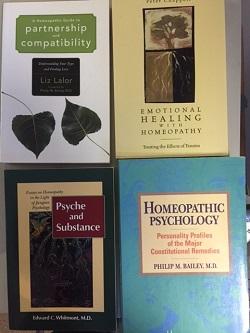Dreams, Symbols, and Homeopathy: Archetypal Dimensions by JANE CICCHETTI [#CICDRE]
$15.16
Description
Cicchetti shows how Jung’s concepts — the archetypes, the collective unconscious, the shadow, and the relationship of the ego to the transpersonal self –can be applied to healing. She describes how dreams can be used in the practice of homeopathy to further probe health and psychological states. Intriguingly bringing her own dreams into her explanations, Cicchetti acquaints the reader with Jung’s typology of psychological classification and develops a symbolic material medica of homeopathic remedies from a Jungian point of view. Cicchetti provides special insights on medicines made from trees, vines, the seven alchemical metals, and milks from various animals.
In this powerful and satisfying new work, Cicchetti contributes to our understanding of the important role of the unconscious in bringing the body back to health.
“A groundbreaking work. A brilliant integration of homeopathy, Jungian psychotherapy, dream analysis, and alchemical symbolism. It picks up where Edward C. Whitmont (The Alchemy of Healing) left off. Eminently useful for homeopaths and others interested in the relationship between the psyche and healing.”
V. Walter Odajnyk, Ph.D.
Jungian analyst and co-editor of Quadrant: Journal of the CG Jung Foundation for Analytical Psychology“Jane Cicchetti’s new book is one of the first to bring homeopathy in line with modern psychology and with Jungian psychology in particular. It brings much clarity to the subjects and helps us to understand their complementary nature.”
Jan Scholten, M.D., author of Homeopathy and the Elements
“One of the most interesting things about this book is that, along with practical information, it opens the reader’s awareness of the archetypal levels of reality therefore creating the opportunity for change. Not only does Jane give a massive amount of information about symbolism and its clinical application, but she also touches the unconscious symbolic world of the reader.
From the very beginning, on reading the first chapter, I felt inspired. This book enriched not only my conscious awareness of the healing process but also enlivened my unconscious world. My dream world started to awaken and I began to understand more about my dreams. The meaning of even very old dreams that I had previously not understood became clear.”
Alize Timmerman
International Teacher of Homeopathy & Director of the Hahnemann Instituut The Hague, Netherlands
Book Review – “Dreams, Symbols, and Homeopathy: Archetypal Dimensions of Healing” by Jane Cicchetti
– Printed in HOMEOPATHY TODAY, a monthly mazazine of the NationalCenter for Homeopathy (www.homeopathic.org) May/June 2004. Reprinted with permission.
Published by North Atlantic Books: Berkeley, California, 2003, paperback, 261 pages, $18.95.
Reviewed by Ken Silvestri, PhD
Since homeopathy is the only form of healing that extensively records the mental and emotional patterns of its remedies and procedures, it stands to reason that finding the simillimum can be enhanced by better understanding the psyche. Hahnemann stresses in aphorism 211 of his Organon (6th edition), that “this preeminent importance of the emotional state holds good to such an extent that the patient’s emotional state often tips the scale in the selection of the homeopathic remedy. This is a decidedly peculiar sign, which, among all the signs of disease, can least remain hidden from the exacting observing physician.”
Despite this, the blending of homeopathic psychology with mind/body healing is largely unexplored. Prior to the writing of Dreams, Symbols, and Homeopathy, few in-depth works are referenced in the homeopathic literature other than books by Edward Whitmont, a soon-to-be-published work by David Little, and a few others. Jane Cicchetti’s wonderfully and clearly written book gently fills this void and defines a profound framework for us to explore this topic. It is useful for those practicing homeopathy, but equally insightful for those who seek further knowledge about the art of homeopathy.
The book consists of four parts, three of which are named after ancient alchemical themes. The first part, “Emergence of Opposites,” explores a much-needed reiteration of the holistic paradigm of homeopathy’s theoretical basis, without which one cannot truly comprehend its power. The “Mercurial Fountain: The Inner World of the Psyche,” puts Jungian archetypes, the shadow, anima/animus and the self into an easily understandable perspective. Part three, “Descent into the Baths: Moving Toward the Union of Opposites,” uses dreams in case-taking in a manner that opens new doors–allowing access to information from collective connections and respecting constitution and temperament. Lastly, “Symbolic Materia Medica,” is a new way to see our materia medica from the wider perspective of symbols and myth–a perspective which very well may be the best possible expression of our quest for greater wholeness.
Understanding homeopathy’s epistemological framework is no easy task without that leap or “Ah” experience which recognizes the “I-Thou” connections that make us whole. Cicchetti quotes Jung regarding our society’s movement to chaos: “Our only hope is for individuals to make a conscious consolidation of opposite forces with themselves to serve as a counter balance.” She then weaves Jung’s view that “healing belongs to the inner life of the individual and is part of the collective human experience,” into a pattern that refutes our “rational” cultural influences of supporting fragmentation.
To Cicchetti, “dreams are the doorway to the symbolic realm of the psyche, a powerful force underlying human consciousness.” What she does so powerfully in her book is to describe the need for a synthesis or bridge and by doing this calls for us to accept the paradoxes of life. “Working with dreams requires that we momentarily leave behind dearly held ideas of reality and immerse ourselves into a realm pregnant with new ideas,” she writes. “It is a creative experience that opens the mind to new possibilities and solutions.” Cicchetti elucidates difficult Jungian concepts such as the shadow, anima, and animus, explaining them in clear ways that are useful to the practice of homeopathy. The book has great case examples to further describe how the self and ego strive for wholeness. She relates these essential concepts to society and cultural constraints and shows how dreams can compensate and are in context to how we evolve and develop.
The section on case-taking is excellent, showing how dreams and symbols are connections to the ancient realm of the collective unconscious. It also demonstrates ways dreams can connect to conscious information and thus be useful for the discipline of homeopathy. Cicchetti further elaborates this process by describing the important topic of psychological types and temperaments. This is written in an eloquent and humbling way that makes sense not only in understanding ourselves as homeopaths but helps us to relate and connect with those who put their trust in us to facilitate their well-being. We need to be aware of our own terrain to put together the essence or “Imbergriff.” “The more aware homeopaths are of their own psychic terrain, the less that terrain will interfere and the more knowledge and energy will be liberated for the patient’s benefit.”
Although the author makes a strong case for the value of using information from the symbolic world, she also cautions homeopaths to use their rational judgment as well as their perception–to allow for an interwoven matrix of symptoms from the conscious experience of the patient as well as the unconscious. This enables the practitioner to see the full repetitive pattern in a case created by the combination of concrete symptoms and symbolism. “Working within the symbolic realm requires that the therapist remain open to seeing this repetitive pattern without coming to premature conclusions as to its nature,” she says. “The Simillimum is only found because there is an inherent order and wisdom that is constantly pointing the way through the symptoms generated by the vital force of the individual. It is only necessary to step out of the way and follow that lead.” Jane Cicchetti uses the framework of “beginners mind” to demonstrate this. She quotes Zen teacher Shunryu Suzuki: “In the beginner’s mind, there are many possibilities but in the expert’s there are few.”
The final part of Jane Cicchetti’s book, “Symbolic Materia Medica,” covers remedies from trees, vines, milk, the seven metals, and lastly remedies that are of value when there is resistance to healing. It is a well-done and innovative journey that links the use of symbols and dreams into a blending with provings found in our materia medica. It allows for much deeper insights and opens the door to further growth in this area. Jane Cicchetti’s quality experiences and profound use of symbols are excitingly integrated into her symbolic materia medica and leave the reader with a shift in how to understand remedies and their uses.
The book is well referenced, has a glossary of Jungian and Alchemical terms, and a concise but useful bibliography. It is a book that reframes case-taking and will greatly assist and profoundly alter how one practices and uses homeopathy. It definitely will be a book located in an accessible place in my library for my regular use.
About the author of this review:
Ken Silvestri, PhD, earned his doctorate in Anthropology and Psychology from Columbia University. He studied classical homeopathy with Luc De Schepper and David Little, and has a full-time practice integrating psychotherapy and homeopathy in Green Village (Chatham Township) and Montclair, New Jersey. He is also a longtime student of Aikido, a martial art devoted to peace and harmony.
ANOTHER IMPRESSIVE REVIEW FOR THIS BOOK…
Published by North Atlantic Books and Homeopathic Educational Services, Berkeley, California. 2003. 259 pages, paperback
Reviewed by Nicholas Nossaman, MD, DHt.
Jane Cicchetti, a consultant and teacher of homeopathy for twenty years, integrates principles of depth (Jungian) psychology into her work in the US and Holland. This is her first book, and it speaks to the incorporation of both disciplines “to help homeopaths and others interested in the relationship between the psyche and healing to use dreams and symbols in their work.” Ms. Cicchetti is well-grounded in sound sources of Jungian concepts, referring liberally to material from Jung himself, as well as from Marie-Louise von Franz and Edward Edinger, the latter two of whom are true to the principles and understanding elucidated by Jung.
Edward Whitmont has been the most articulate spokesman for the natural kinship between homeopathy and Jungian psychology, and devoted a good segment of the latter part of his life to conveying this information to homeopaths and Jungians alike. Ms. Cicchetti, one of the next generation of that same hybrid, carries on the work and does an admirable job in this engaging volume.
The book is well-indexed and contains a chapter-by-chapter bibliography as well as a separate list of references pertaining to Jungian psychology, homeopathy and mythology, symbolism and spirituality. It also has within it a glossary of Jungian and alchemical terms which I would have liked to contain more concepts such as “identification” and “projection,” both of which she does explain to some degree in the text.
In the first notes of this opus, Ms. Cicchetti portrays the theme of emergence and coexistence of opposites, both in the world’s approach to healing (rationalist and empiricist medicine) and as existing in the individual patient (the myths which alienate us from our true selves), and supports the usefulness of dreams in advancing the reconciliation of the opposites. She describes a series of her own dreams in which the mythical archetype of Mercurius emerges, leading her to the personal confirmation of the alchemical principle of transformation of the practitioner in the search for the healing principle which will aid him or her in their work Throughout the volume, she liberally refers to alchemical concepts, images and symbols, weaving them into her discussion of homeopathy and its relationship with depth psychology.
Following a short discussion of the principles of homeopathy, the author addresses mind-body issues, including a wonderful anecdote about Jung which echoes Hahnemann’s entreaties about being unprejudiced observers. She emphasizes here, and elsewhere in the book – and backs it up with well-reasoned justification – the importance of the psychological work of the caregiver on him or herself. This is again in tune with the richness of what alchemy has to teach us. This accomplishment of inner work on the part of the caregiver is crucial as it relates to transference and countertransference with the patient and in life in general and is addressed more fully later in the book. This is an element of learning which is to a large degree neglected in medical school as well as in homeopathic training.
The author does a concise but rich explication of the concept of archetypes, relating them to the symbolic content of dreams and visions. Throughout the volume she refers liberally to the mythology of many cultures. As the volume progresses, she describes other Jungian concepts, including typology and the elements of the unconscious. She further asserts the crucial modern need of integrating awareness of the archetypal realms with scientific explorations.
Ms. Cicchetti addresses the concepts of shadow, anima and animus-all of which are necessary to understand what Jung was saying-and illustrates their practical value in understanding patients, with examples of homeopathic cases. A nice quote in her chapter on the shadow speaks to the notion of the patient being responsible for the cause of his or her own disease: “To accuse an individual of creating disease is misguided and insulting. What is being discussed here is an interior state that exists previous to thought and is not under control of the conscious mind.”
In her chapter on wholeness, the author traces the parallels in the progress of a woman patient with the evolution of her dream content. Later she describes the history of dreams and how they have been regarded by various cultures. She then describes the process of dream analysis, before integrating it with the homeopathic approach. The initial theme of emergence and coexistence of opposites is revisited, with the integration of dream analysis and homeopathy as potent ingredients in pursuit of the goal of reunion of the opposites.
Her perspective on dreams in relation to the dream section of the Repertory (i.e., the appearance of dreams in provings) is interesting, resonating in many respects with the opinions of Whitmont in the emphasis on their personal nature and requiring infor ation about the associations they evoke in the individual.
The latter part of the book is mostly devoted to an ambitious explication entitled “Symbolic Materia Medica.” A chapter on trees, including the results of the author’s conduction of a proving of a tree from the rainforests of Costa Rica, Ecuador and Colombia, Brosimum utile, touches on many fascinating areas of the symbolism of trees, connections with other tree provings, and relation of trees with various mythologies. Vines and various milk remedies are also addressed, followed by the homeopathic links with the seven minerals of the alchemist. This is also spiced liberally with symbolic and mythological references. found it to be welcome as a concrete integration of alchemical and homeopathic views of the same substances. In such description of “essences” it seems that what is gained is a poetic connection of pictures of our medicines – sometimes speculative, unfortunately – with material and symbolic attributes of the substances in question; and what is lost is the awareness of the breadth of individual applications of these medicines where there is no essence but only a small focused set of general and specific symptoms which indicate the remedy.
Despite this observation, the section is exceedingly rich in mythological and alchemical correlations with homeopathy and has to my knowledge never been undertaken in such detail and breadth. (Twentyman and Whitmont have written somewhat similar treatises regarding individual minerals.)
The final chapter, regarding the Internal Saboteur and some remedies for it, seemed somewhat out of step with the rest of the book in that it seems that the author had previously made a good case for the existence of the internal saboteur in the unconscious of each of us. Therefore it seems questionable that the need for reconciliation of opposites, which is addressed by homeopathic and depth psychological activities, isn’t confined to a limited set of remedies.
In summary. this book is a generally sound, unique and comprehensive explication of the fruitful marriage of homeopathy and depth psychology. It is thick with understanding and imagery, is written in a very readable style and is a valuable trail-breaker for the understanding of human health and disease. One of Dr. Whitmont’s dreams was to educate the Jungian and homeopathic communities about each other’s disciplines. Ms. Cicchetti has succeeded nicely in advancing this cause.






Reviews
There are no reviews yet.